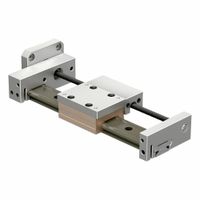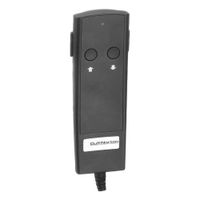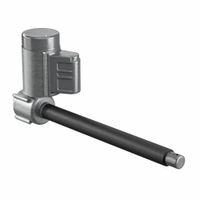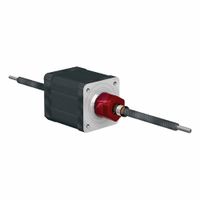Call +(254) 703 030 000 / 751 483 999 / 721 704 777
- Home
- Power Transmission
- Linear Motion
- Linear Actuators Screw Jacks
.....Read More
Frequently Asked Questions
What is a linear actuator and how does it work?
A linear actuator is a device that creates motion in a straight line, as opposed to the circular motion of a conventional electric motor. It is used in machinery and equipment where linear motion is required, such as in industrial machines, robotics, and consumer products like adjustable beds and recliners.
Linear actuators work by converting energy, typically electrical, into mechanical motion. The most common types include:
1. **Electric Linear Actuators**: These use an electric motor to drive a screw or lead screw, which in turn moves a nut along the screw's threads, creating linear motion. The motor's rotation is converted into linear displacement, allowing precise control over the position and speed of the actuator.
2. **Hydraulic Linear Actuators**: These use pressurized hydraulic fluid to produce motion. A piston inside a cylinder is moved by the fluid, creating linear motion. They are known for their high force capabilities and are often used in heavy-duty applications.
3. **Pneumatic Linear Actuators**: Similar to hydraulic actuators, but they use compressed air instead of hydraulic fluid. They are typically used in applications where lower force is sufficient and where speed and simplicity are important.
4. **Mechanical Linear Actuators**: These include rack and pinion systems, cam actuators, and other mechanical linkages that convert rotary motion into linear motion.
Linear actuators are chosen based on factors like load capacity, speed, stroke length, and environmental conditions. They are integral in applications requiring precise positioning, such as in automation systems, where they can be controlled by computer systems for tasks like opening valves, moving robotic arms, or adjusting machine components.
What are the different types of linear actuators?
Linear actuators are devices that create motion in a straight line, as opposed to the circular motion of a conventional electric motor. The different types of linear actuators include:
1. **Mechanical Actuators**: These use mechanical components like screws, gears, or cams to convert rotary motion into linear motion. Common types include:
- **Screw Actuators**: Utilize lead screws or ball screws to achieve linear motion.
- **Rack and Pinion Actuators**: Use a rotating pinion engaging a linear rack to produce motion.
2. **Hydraulic Actuators**: Use pressurized hydraulic fluid to produce linear motion. They are known for high force capabilities and are often used in heavy-duty applications.
3. **Pneumatic Actuators**: Operate using compressed air to generate motion. They are typically used in applications requiring rapid movement and are less powerful than hydraulic actuators.
4. **Piezoelectric Actuators**: Utilize the piezoelectric effect, where certain materials expand or contract when an electric voltage is applied. They are used for precise, small-scale movements.
5. **Electromechanical Actuators**: Combine electrical and mechanical components to convert electrical energy into linear motion. They often use motors coupled with mechanical systems like lead screws.
6. **Magnetic Actuators**: Use magnetic fields to produce motion. Linear motors are a type of magnetic actuator that directly produces linear motion without the need for mechanical conversion.
7. **Thermal Actuators**: Rely on the expansion and contraction of materials due to temperature changes to create motion. They are often used in applications where slow, controlled movement is required.
Each type of linear actuator has its own advantages and is chosen based on factors like force requirements, speed, precision, and environmental conditions.
How do you choose the right linear actuator for an application?
To choose the right linear actuator for an application, consider the following factors:
1. **Load Requirements**: Determine the weight and force the actuator needs to move. This will dictate the actuator's load capacity.
2. **Stroke Length**: Identify the distance the actuator needs to extend and retract. This is the stroke length, which should match the application's requirements.
3. **Speed**: Decide how fast the actuator needs to move. Speed requirements can affect the choice of motor and gearing.
4. **Precision and Control**: Consider the level of precision needed. Applications requiring precise positioning may need actuators with feedback systems like encoders.
5. **Duty Cycle**: Evaluate how often the actuator will operate. A high duty cycle requires an actuator designed for frequent use.
6. **Environment**: Assess the operating environment. Factors like temperature, humidity, and exposure to dust or chemicals can influence the choice of materials and protection ratings (e.g., IP ratings).
7. **Power Source**: Determine the available power source (AC, DC, or battery) and ensure compatibility with the actuator's motor.
8. **Mounting and Space Constraints**: Consider the available space and mounting options. The actuator's size and mounting configuration should fit the application.
9. **Cost**: Balance the budget with performance needs. Higher performance or specialized actuators may cost more.
10. **Manufacturer Support and Warranty**: Consider the manufacturer's reputation, support services, and warranty offerings.
By evaluating these factors, you can select a linear actuator that meets the specific needs of your application, ensuring optimal performance and longevity.
What are the advantages of using linear actuators over hydraulic or pneumatic systems?
Linear actuators offer several advantages over hydraulic and pneumatic systems:
1. **Precision and Control**: Linear actuators provide high precision and control over movement, allowing for accurate positioning and repeatability. This is particularly beneficial in applications requiring fine adjustments.
2. **Efficiency**: They are generally more energy-efficient as they convert electrical energy directly into linear motion without the need for fluid power, reducing energy losses associated with hydraulic and pneumatic systems.
3. **Maintenance**: Linear actuators require less maintenance since they have fewer moving parts and do not involve fluids that can leak or require regular replacement. This leads to lower operational costs and downtime.
4. **Cleanliness**: They are cleaner and more environmentally friendly, as they do not use oils or compressed air, eliminating the risk of leaks and contamination, which is crucial in industries like food processing and pharmaceuticals.
5. **Noise**: Linear actuators operate more quietly compared to pneumatic and hydraulic systems, which is advantageous in environments where noise reduction is important.
6. **Installation and Integration**: They are easier to install and integrate into existing systems, as they do not require complex infrastructure like pumps, compressors, or fluid reservoirs.
7. **Size and Weight**: Linear actuators are typically more compact and lightweight, making them suitable for applications with space constraints or where weight is a critical factor.
8. **Safety**: They offer enhanced safety features, as they do not involve high-pressure fluids, reducing the risk of accidents related to leaks or bursts.
9. **Cost**: While the initial cost may be higher, the long-term savings in energy, maintenance, and operational efficiency can make linear actuators more cost-effective over time.
These advantages make linear actuators a preferred choice in many applications, particularly where precision, cleanliness, and efficiency are paramount.
How do you maintain and troubleshoot linear actuators?
To maintain and troubleshoot linear actuators, follow these steps:
1. **Regular Inspection**: Periodically check for physical damage, wear, or corrosion. Inspect the housing, seals, and mounting brackets for any signs of deterioration.
2. **Lubrication**: Ensure that moving parts are adequately lubricated to reduce friction and wear. Use the manufacturer-recommended lubricant and apply it to the screw, nut, and other moving components.
3. **Cleanliness**: Keep the actuator clean from dust, dirt, and debris. Use a soft cloth to wipe down the exterior and ensure that the actuator's environment is free from contaminants.
4. **Electrical Connections**: Check all electrical connections for tightness and corrosion. Ensure that the power supply is stable and that the actuator is receiving the correct voltage.
5. **Alignment**: Verify that the actuator is properly aligned with the load. Misalignment can cause excessive wear and reduce efficiency.
6. **Load Capacity**: Ensure that the actuator is not overloaded. Operating beyond its rated capacity can lead to premature failure.
7. **Noise and Vibration**: Listen for unusual noises or vibrations during operation, which can indicate mechanical issues or misalignment.
8. **Troubleshooting**:
- **Non-Operation**: Check power supply, fuses, and connections. Ensure the control system is functioning.
- **Erratic Movement**: Inspect for obstructions, check alignment, and verify that the actuator is not overloaded.
- **Overheating**: Ensure proper ventilation and check for excessive load or duty cycle.
- **Slow Operation**: Check for mechanical binding, low voltage, or insufficient lubrication.
9. **Documentation**: Keep a maintenance log detailing inspections, repairs, and replacements to track the actuator's performance and anticipate future issues.
By following these steps, you can ensure the longevity and reliability of linear actuators.
What are the common applications of linear actuators?
Linear actuators are widely used in various industries and applications due to their ability to convert rotational motion into linear motion. Here are some common applications:
1. **Industrial Automation**: Linear actuators are integral in manufacturing processes, facilitating tasks such as material handling, assembly line automation, and robotic arms.
2. **Medical Equipment**: They are used in hospital beds, patient lifts, and dental chairs to provide precise and smooth adjustments for patient comfort and accessibility.
3. **Aerospace and Defense**: In these sectors, linear actuators are employed for controlling flight surfaces, landing gear systems, and weapon systems due to their reliability and precision.
4. **Automotive Industry**: They are used in adjustable seats, automatic trunk openers, and convertible roof systems, enhancing vehicle functionality and user comfort.
5. **Home Automation**: Linear actuators are found in adjustable furniture, such as recliners and standing desks, as well as in smart home systems for automated windows and doors.
6. **Renewable Energy**: In solar panel systems, linear actuators adjust the angle of panels to optimize sunlight exposure, increasing energy efficiency.
7. **Agriculture**: They are used in machinery for tasks like adjusting the position of plows, seeders, and harvesters, improving precision and productivity.
8. **Marine Applications**: Linear actuators are used in boat hatches, adjustable seating, and steering mechanisms, providing durability and resistance to harsh marine environments.
9. **Entertainment and Stage Technology**: They enable dynamic movement in stage props, lighting rigs, and special effects, enhancing performance experiences.
10. **HVAC Systems**: Linear actuators control dampers and valves, regulating airflow and temperature in heating, ventilation, and air conditioning systems.
These applications highlight the versatility and essential role of linear actuators in modern technology and industry.
How do you integrate linear actuators with control systems?
To integrate linear actuators with control systems, follow these steps:
1. **Selection of Actuator**: Choose a linear actuator that meets the required specifications such as stroke length, load capacity, speed, and environmental conditions.
2. **Control System Compatibility**: Ensure the actuator is compatible with the control system. This involves checking the voltage, current requirements, and communication protocols (e.g., analog, digital, PWM, or serial communication).
3. **Feedback Mechanism**: Incorporate feedback devices like potentiometers, encoders, or limit switches to provide position feedback to the control system, enabling precise control and automation.
4. **Controller Setup**: Use a microcontroller, PLC, or dedicated motor controller to manage the actuator. Program the controller to handle inputs, process feedback, and execute control algorithms (e.g., PID control) for accurate positioning and movement.
5. **Wiring and Connections**: Properly wire the actuator to the control system, ensuring secure and correct connections for power, ground, and signal lines. Use relays or motor drivers if necessary to handle higher power requirements.
6. **Software Integration**: Develop or configure software to interface with the actuator. This includes writing code to send commands, read feedback, and implement control logic. Use libraries or APIs if available for easier integration.
7. **Testing and Calibration**: Test the system to ensure the actuator responds correctly to control inputs. Calibrate the system by adjusting parameters to achieve desired performance, such as speed, accuracy, and response time.
8. **Safety and Redundancy**: Implement safety features like emergency stops, overload protection, and redundant systems to prevent failures and ensure safe operation.
9. **Documentation and Maintenance**: Document the integration process, including wiring diagrams, software code, and calibration settings. Establish a maintenance schedule to ensure long-term reliability and performance.



